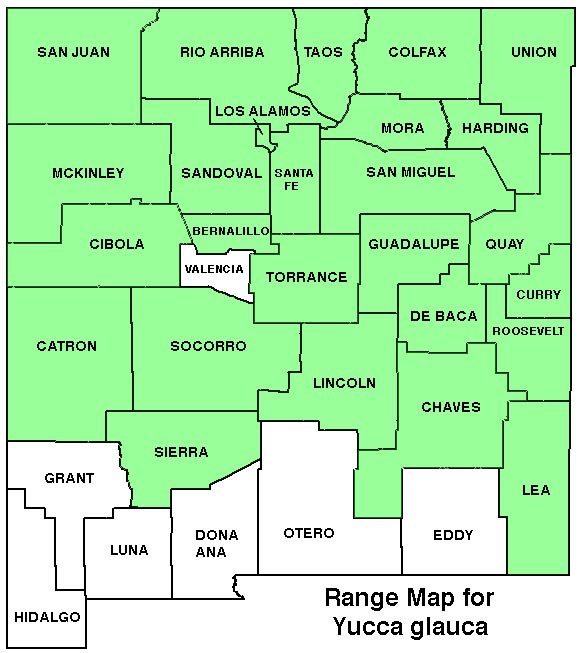WILDFLOWERS OF NEW MEXICO

Occurring from the Great Plains to the foothills of the Rocky Mountains, from Canada through the southwest, and cold hardy to –50 degrees, this is the most widespread yucca in North America. The flower stalk begins within or close to the top of the rosette of stiff leaves. Flowers typically grow directly from the stalk and not on short branches. Note the flower has a dark green stigma, and the leaves are greater than 3/8 inch wide.
FLOWER: May–June. The flower stalk (scape), 18–36 inches long (50–100 cm), rises from the basal rosette with a loose cluster of flowers, usually a raceme (unbranched, spike-like) but occasionally the lower portion may have short branches. Flowers are bell-shaped, 2 inches long (5 cm) with 6 white to greenish-white petals (tepals). Note the style is dark green (not cream-colored). Fruit is an erect, egg-shaped capsule that dries and splits open; seeds black, wafer-like.
LEAVES: Basal rosette. Blades linear, 15–24 inches long (40–60 cm) and 3/8–1/2 inch wide (8–12 mm); margin has a narrow white edge and few to many thread-like fibers.
HABITAT: Dry sandy soils; prairies, pastures, hills, foothills; shortgrass prairies, pinyon-juniper-oak woodlands.
ELEVATION: 4,750–8,700 feet.
RANGE: AR, CO, IA, KS, MO, MT, NE, NM, ND, OK, SD, TX, WY.
SIMILAR SPECIES: Three species in NM have a flower stalk that starts blooming within the leaves. Narrowleaf Yucca, Y. intermedia, in cen. and no.-cen. NM, has a cream-colored stigma, a flower stalk 1.5–2.5 times the length of the leaves, and leaves less than 3/8 inch wide. Bailey’s Yucca, Y. baileyi var. baileyi in nw NM, has a creamy style and a flower stalk less that 1.5 times the length of the leaves.
NM COUNTIES: Much of NM in low to mid-elevation sandy habitats: Bernalillo, Catron, Chaves, Cibola, Colfax, Curry, De Baca, Guadalupe, Harding, Lea, Lincoln, Los Alamos, McKinley, Mora, Quay, Rio Arriba, Roosevelt, San Juan, San Miguel, Sandoval, Santa Fe, Sierra, Socorro, Taos, Torrance, Union.
NOTE: Each species of yucca is pollinated only by a single moth species in the genus Tegeticula (see photo). The little white moth carries pollen from one yucca to the next, places the pollen in the stigma, then lays its eggs in the ovary. The larva hatch and eat a few of the developing seeds, then burrow out and crawl down the trunk and pupate in the ground. They don’t emerge as adults until the yucca blooms again, which may take several years. The moths emerge, reproduce, and die without ever eating.

SOAPWEED (GREAT PLAINS) YUCCA
YUCCA GLAUCA
Asparagus Family, Asparagaceae (formerly in Agave Family, Agavaceae)
Perennial shrub

THE CONTENTS OF THIS WEBSITE ARE COPYRIGHTED AND CANNOT BE USED
WITHOUT PERMISSION OF GEORGE OXFORD MILLER
EMAIL ME






Flowers have a dark green style.
Yuccas and moths in the genus Tegeticula depend on each other exclusively for reproduction.


The blooms begin within the rosette of leaves.

The leaves are greater than 3/8 inch wide with white margins with some treads .


Flowers grow from stem, which does not have branches (only occasionally near bottom).


Occurring throughout the Great Plains from Texas-New Mexico to Canada, Plains Yucca is the most widespread yucca in North America. Here it decorates the Boot Hill Cemetery in Ogallala, Nebraska, which commemorates the cattle drive era.